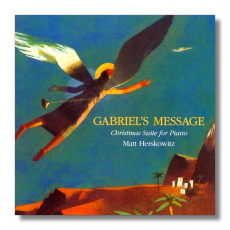
The Internet's Premier Classical Music Source
Related Links
- Latest Reviews
- More Reviews
-
By Composer
-
Collections
DVD & Blu-ray
Books
Concert Reviews
Articles/Interviews
Software
Audio
Search Amazon
Recommended Links
Site News
 CD Review
CD Review
Gabriel's Message

Christmas Suite for Piano
- Gabriel's Message
- Frosty The Snowman
- Adeste Fideles
- Silent Night
- Rudolph The Red-Nosed Reindeer
- Little Town of Bethlehem
- God Rest Ye Merry, Gentlemen
- Carol of The Bells
- The Christmas Song
Matt Herskowitz, piano
Lefthand Music LHCON01
[ Available from the composer at http://www.mattherskowitz.com/. ]
This is the most unusual Christmas album I've ever encountered. Actually, in a sense, it's unfair to limit it to the realm of Christmas music, because most of what's on this CD reaches well beyond the moods and sentiments associated with that most commercial of our holidays. Moreover, it is one of those recordings one can hardly classify with regard to genre: is it primarily Classical? or do its jazz elements make it a crossover album? Probably more the latter.
A little background information about composer/pianist Herskowitz might shed some light on the situation here. A graduate of the Curtis Institute of Music and also Juilliard-trained, Montréal-based Herskowitz has his own jazz ensemble, but can't seem to (or doesn't want to) divorce himself from classical music. His debut CD on Chandos of the Glazunov Piano Concerto was an immense success. Ditto for his "Lucid" album, on the Ethereal label, which mixed jazz and classical elements in original compositions by Heskowitz. In the recording under review here one also hears this mixture, but with the tilt going more to the classical side.
Without doubt the best piece is the title number and the first cue on the disc, Gabriel's Message. This is a work that begins as a theme-and-variations scheme that subtly evolves into a bluesy jazz near the mid-point, just after it seemed to be developing a Rachmaninoffian angst. But that's not as big a switch as you might think: Rachmaninoff liked to improvise jazz, let's not forget, and some of his music bordered on that style.
The shortest piece on the CD, Adeste Fideles, is one of the most interesting. It's as if Debussy and Schoenberg collaborated in a rendition of this traditional piece and fashioned a most attractive mutation – the key is weird, the plentiful dissonance jarring and the mood and colors bizarre. Yet, the results are compelling. Your next-door neighbor might not like it, but you, yours ears perversely pleased, will find it clever and full of personality.
Most of the rest of the pieces are also quite inventive and colorful. Carol of The Bells, for which Herskowitz acknowledges a Rachmaninoff influence, is one of the most compelling entries here. It has a Russian gloom in its anxieties, and features vivid wintry colors. Its ending is sheer magic.
In the end, this album offers individuality and character, despite packaging that might suggest it's just another Christmas-favorites album. The sound is vivid and the notes, mostly by Herskowitz, are informative. Strongly recommended.
Copyright © 2001, Robert Cummings


















